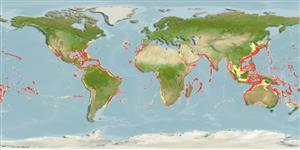Common names from other countries
>
Scombriformes (Mackerels) >
Gempylidae (Snake mackerels)
Etymology: Diplospinus: Greek, diploos = twice + Latin, spina = spine, thorn (Ref. 45335).
Environment: milieu / climate zone / depth range / distribution range
Ecologie
marien benthopelagisch; diepte 50 - 1000 m (Ref. 9784). Deep-water; 42°N - 38°S, 180°W - 180°E
Atlantic, Indian and Pacific: in central water masses. Rather rare, but relatively abundant in the northwest and southeast Atlantic and southeast Pacific Ref. 6181).
Lengte bij maturiteit / Grootte / Gewicht / Leeftijd
Maturity: Lm ?, range 16 - ? cm
Max length : 33.0 cm SL mannelijk / geslacht onbekend; (Ref. 9784); common length : 20.0 cm SL mannelijk / geslacht onbekend; (Ref. 6181)
Dorsale stekels (totaal) : 30 - 36; Dorsale zachte stralen (totaal) : 35 - 44; Anale stekels: 2; Anale zachte stralen: 28 - 35; Wervels: 57 - 64. Body is extremely elongate and compressed. Lower jaw extends anterior to upper jaw with a small conical dermal process. Upper jaw with 3 immovable and 3 or 4 movable fang-like teeth anteriorly. Lateral line situated closer to the ventral profile than the dorsal profile posteriorly. Color is silvery with narrow dark dotted lines along the body; the gill membranes are jet-black.
Oceanic, migrating upward at night to 100 to 200 m (Ref. 6181). Probably forming schools during daytime (Ref. 6181). Feed on crustaceans and small fish (Ref. 6181). Females mature at about 16 cm (Ref. 36731). Eggs and larvae are pelagic (Ref. 6766).
Nakamura, I. and N.V. Parin, 1993. FAO Species Catalogue. Vol. 15. Snake mackerels and cutlassfishes of the world (families Gempylidae and Trichiuridae). An annotated and illustrated catalogue of the snake mackerels, snoeks, escolars, gemfishes, sackfishes, domine, oilfish, cutlassfishes,. scabbardfishes, hairtails, and frostfishes known to date. FAO Fish. Synop. 125(15):136 p. (Ref. 6181)
Status op de Rode Lijst van het IUCN (Ref. 130435)
CITES (Ref. 128078)
Not Evaluated
Gevaar voor de mens
Harmless
Gebruik door de mens
Visserij: visserij voor eigen gebruik
Tools
Speciale rapporten
Download XML
Internetbronnen
Estimates based on models
Preferred temperature (Ref.
115969): 8.7 - 19.2, mean 13.1 (based on 808 cells).
Fylogenetische diversiteitsindex (Ref.
82804): PD
50 = 1.0000 [Uniqueness, from 0.5 = low to 2.0 = high].
Bayesian length-weight: a=0.00363 (0.00163 - 0.00807), b=3.10 (2.91 - 3.29), in cm Total Length, based on LWR estimates for this (Sub)family-body shape (Ref.
93245).
Trofisch niveau (Ref.
69278): 3.5 ±0.52 se; based on food items.
Weerstandsvermogen (Ref.
120179): Gemiddeld, minimale populatieverdubbelingstijd 1,4-4,4 jaar (Fec=1,200).
Fishing Vulnerability (Ref.
59153): Low to moderate vulnerability (30 of 100).
